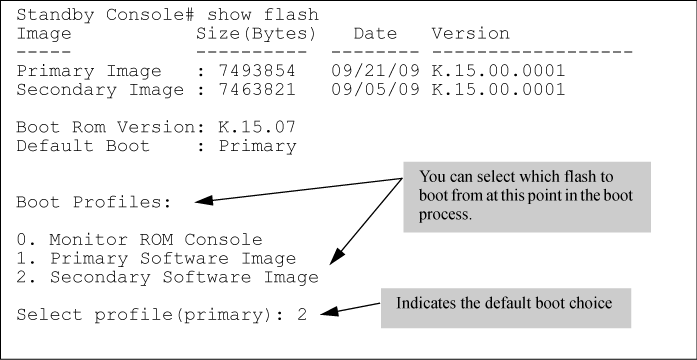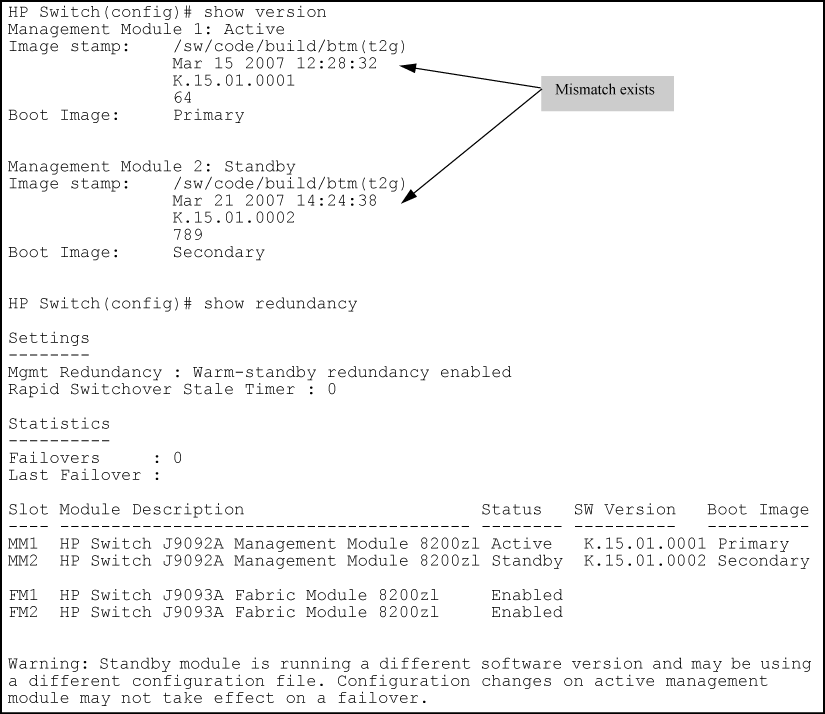After downloading a new software version to either the primary or secondary flash of the active management module, the software version is immediately copied to the corresponding flash (primary or secondary) of the standby module, unless the standby module failed selftest or redundancy was disabled with the no redundancy management-module command.
The configuration files, including which configuration file to use for that flash image, are synchronized. For example, if the active management module is using config1, the standby module is also synchronized to use config1.
Example of upgrading software version K.15.01.0003 to version K.15.01.0004
| Newer code to secondary flash | New code to primary flash | |||
|---|---|---|---|---|
| Active MM | Standby MM | Active MM | Standby MM | |
| Software version downloaded to Primary flash image | K.15.01.0003 | K.15.01.0003 | K.15.01.0004 | K.15.01.0004 |
| Software version downloaded to Secondary flash image | K.15.01.0004 | K.15.01.0004 | K.15.01.0003 | K.15.01.0003 |
After installing the new software to the active management module, wait a few minutes, and then verify that the standby management module has been synchronized with the new software as well (use the show flash command.) If the default flash for boot is set correctly, you can start the standby management module on the new software by executing the boot standby command. This does not interrupt current switch operations yet. After the standby management module has rebooted and is ready for takeover in standby mode (you can verify this using the show redundancy command.) you can now switch over to the management module running the newer software with this command:
This causes a switchover to the management module that received the new software version, which becomes the active management module. This method incurs the least amount of network downtime for booting. If downtime is not an issue, use the boot system command. Both management modules are then running the new software version.
When a new software version is downloaded to the active management module, it is immediately copied to the corresponding flash (primary or secondary) in the standby management module, unless redundancy has been disabled. If the standby management module is rebooted, it will be running a different software version than the active management module. You can direct the standby module to boot from the non-corresponding flash image that has a different software version during the actual reboot process of the standby module when the prompt to select the Boot Profile appears, as shown in Booting the standby management module to secondary flash.
When you enter the show redundancy command and a software version mismatch exists, a warning message is displayed, as shown at the bottom of Example of a software version mismatch between the active and standby modules.
If the software version on a management module becomes corrupted, you may need to do a serial download to restore the affected module. The non-corrupted management module becomes the active module. You can then use the serial port on the corrupted management module to download a new software version. When the corrupted module is rebooted, the software version in the corrupted module is immediately overwritten by the software version in the active management module. Both management modules should now operate on the same software version.

![[CAUTION: ]](images/caution.gif)
